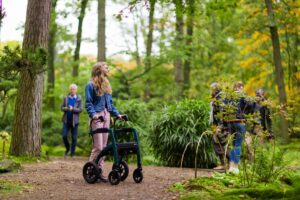
«Accessibility is a business opportunity for destinations and companies to embrace all visitors and enhance their revenues,» reads UN Tourism. To put words into numbers: Accessible tourism is a billion-dollar market. Europe alone is projected to reach almost 90 billion euros annually by 2030—and it is good news for the hospitality industry, travellers and citizens alike.
According to the World Health Organization, in 2023, 16% of the global population, or roughly 1.3 billion people, experienced a “significant disability”, and almost 50% of the 60+ had an impairment. This image alone shows how more accessible cities could benefit most people.
Let’s then consider that in developed economies worldwide, about 2/3 of people with disabilities are likely to have the financial means to travel and pay for entertainment, and, in most cases, they are accompanied on average by two people. Indeed, there’s business potential there.
Opportunities for businesses
Discussions around accessibility, the planning for services for various needs, and special offers for people with a disability have been spreading for years. Truth be told, the approval of the Americans with Disabilities Act and the European Accessibility Act have prompted the decades-long and widespread introduction of disabled-friendly venues. Yet development and renovations were primarily (if not exclusively) oriented toward wheelchair users’ needs.
More recently, the economic opportunities for a great variety of businesses, a growing sensibility, the assortment and affordability of many innovations are driving more extensive changes. Richer offers and greater attention are put into accommodating more varied accessibility needs—a growing attention that considers physical and mental, visible and less visible impairments.
Even if the economic side is not the loudest narrative, in a field filled with other concerns, some point out that there is far less need to convince businesses of the opportunity and benefit to invest in accessible features. The numbers back up perceptions and theories. As the BBC reported at the beginning of the year, «in 2015, disabled travellers represented a $35bn (£27.4bn) market. In 2020, the number jumped by 63%. For 2023, the industry is poised to break the $60bn (£47bn) mark.»
Benefits for most
It may be difficult, especially from a business perspective, to spot opportunities to improve services by renovating existing structures through costly structural interventions, such as updating a building to become wheelchair-accessible. Yet, today, hotels, restaurants, and tour services often embrace the potential of offering improved services with creativity—and not only through expensive installations. From museums’ “quiet hours” to accessible versions of websites or apps that help move around a neighbourhood, the possibilities at hand are various. Especially in Europe
If projections are correct, the continent will again be the destination for a growing number of tourists this summer—only partially boosted by the UEFA football championship in Germany or the Olympic Games in Paris. Contrary to what some hot spots are doing, like Barcellona, Amsterdam, and Venice, which put into force actions to contrast over-tourism (from entry fees to discouraging tourists from entering a city altogether), less mainstream destinations are working on their appeal to become holiday destinations.
And more are seeing the potential in investing to become more accessible. It is a market, according to a study by the European Network for Accessible Tourism (ENAT), that by 2030 could reach up to € 88.6 billion annually.
Not only expensive renovations
Improvements do not always come with a hefty price tag. Undoubtedly, many places still need to provide expensive developments, from more widespread movable ramps to access buses and trains to lifts to reach underground platforms. Or, on the street level, intervene to create smoother and more accessible pavements. However, some beneficial improvements can be as simple as offering accessible booking platforms, developing tours to allow travellers with (and without) impairments to navigate cities’ amenities better, and using augmented or virtual reality technologies to improve museum visits.
The potential is there. As is the demand. Now, it needs to be better answered because, in truth, much remains to be done. Besides the undeniable advancements, those travelling with a disability (or even with a stroller or a walker) still encounter more than few obstacles.
***
Alley Oop’s newsletter
Alley Oop arrives in your inbox every Friday morning with news and stories. To sign up, click here.
If you want to write to or contact Alley Oop’s editorial team, email us at alleyoop@ilsole24ore.com.